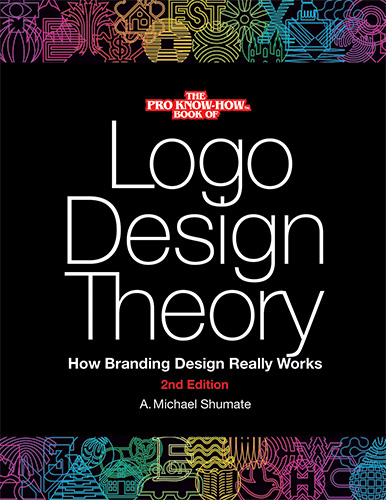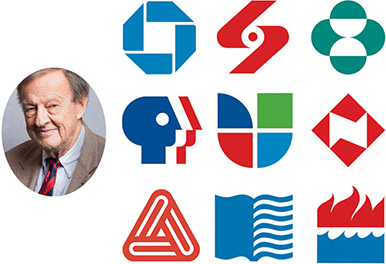Logo Design Theory
How Branding Design Really Works
The profession of graphic design has undergone a revolution during the last few decades. Typesetters, stat camera operators, photoengravers have all been replaced to large measure by graphic designers and the powerful software programs they wield. Of a necessity, design education has had to use more time to teach that software and, to a large extent, curriculum on design principles has been reduced. Now, even the teachers who instruct today’s students were never taught in many of those principles. Designers today try to figure out the principles of branding design. It is a hit and miss process. Some things work, some don’t.
It doesn’t have to be that way.
Logo Design Theory remedies some of that with:
• Professional, Prima Donna or Artsy-Fartsy?
• Four myths about creativity & what it really is.
• What history teaches about effective logos.
• How many kinds of identity concepts
are there.
• How knowing that can help generate more and better identity concepts
• The Seven Deadly Sins of Logo Design.
• Techniques that can turn a common concept into an uncommon, or even a
remarkable identity.
• Some of the “famous fails” of recent
logo design.
• There really are core principles of branding design that don’t change, that transcend
fad and fashion.
For Graphic Designers and Brand Managers
Second Edition • 170 pages • 8.5 x 11
2100+ color & b&w illustrations / examples
ISBN: 9781777016807
Library of Congress Control Number 1777016800
Distributed by Ingram
$27.95 Perfect Bound Paperback
Publication date: 1 June, 2020
Outline
Section One: Foundational Principles
of Graphic Design
In our digital age many design schools concentrate so much on software that some basic precepts may be missing from the curriculum. Here are some essential principles that have a huge impact on branding design.
• Professional, Prima Donna or Artsy-Fartsy?
• Seeking True Principles in Art and Design
• Four Myths About Creativity
• The Purpose of Graphic Design
• Form Follows Function
• Basic Principles of Design
• Legibility & Contrast
• Color and Contrast
• The Doctrine of Coincide or Contrast
Section Two: Branding Fundamentals
Understanding some basics of branding history, both ancient and recent, will give us perspective on branding design today.
• A brief Overview of Branding History
• Evolution of Some High Profile Identities
• Great Designers of the Last Century
• Big Branding Agencies and Studios
Section Four: Core Principles:
Seven Deadly Sins of Logo Design
Several common approaches to identity design prevent an identity from working in ways that every identity should be able to work.
• Logo Design Blowout
• The Seven Deadly Sins of Logo Design:
• #1: Can’t Work in Solid Black
• #2: Lack of Mass
• #3: Obscure Contrast
• #4: Wayward or Parts Out of Harmony
• #5: Overlapping Elements
• #6: Unrefined Shapes
• #7: Tiny Elements, Thin Lines
• What’s Left?
Section Five: Core Principles:
Visual Techniques
Any given concept can be executed in virtually endless ways. These techniques can transform a common concept into an uncommon, or even remarkable final identity.
• Ten Visual Techniques:
• #1 Containment
• #2: Planar or Silhouette
• #3: Fragmentation
• #4: Unique Coincidence
• #5: Linear Treatment
• #6: Ligatures, Swashes and Flourishes
• #7: Negative Shapes
• #8: Essence
• #9: A System of Shapes
• #10: Sculpted Type
Section Six: Core Principles:
Color, Typographic & Spatial Issues
Even superior designs can be undermined by poor color, typographic or spatial choices. Ways to prevent that.
• Logo and Signature Color Basics
• Advanced Color Issues for Identities
• Typographic Issues with Signatures
• Spatial Issues with Identities
Section Seven: Implementing
Core Principles of Identity Design
Hundreds of current examples demonstrate the consequences of deviating from the Core Principles of Branding Design as well as the benefits of redesigning an identity to abide by them.
• The Danger of Following Trends Blindly
• Deadly Sins of Logo Design Fixed:
• #1 Able to be in Solid Black
• #2 Having Sufficient Mass
• #3 Having Enough Contrast
• #4 Removing Wayward Parts
• #5 Having No Overlapping Elements
• #6 Making More Refined Shapes
• #7 Omitting Thin Lines or Tiny Shapes
• Good 21st Century Identity Design Trends
• Famous Fails
• Correction at a Cost
• Learning From the Past
• Responsive Websites, Avatars & Favicons
• Working at Creativity
• Final Words
• Appendix 1: Glossary
• Appendix 2: Logos by A. Michael Shumate
• Index


